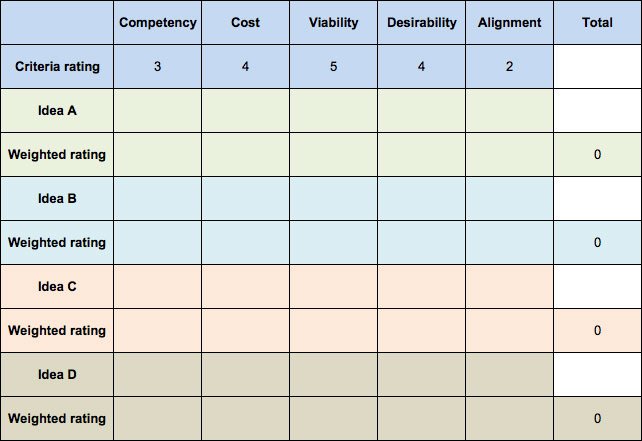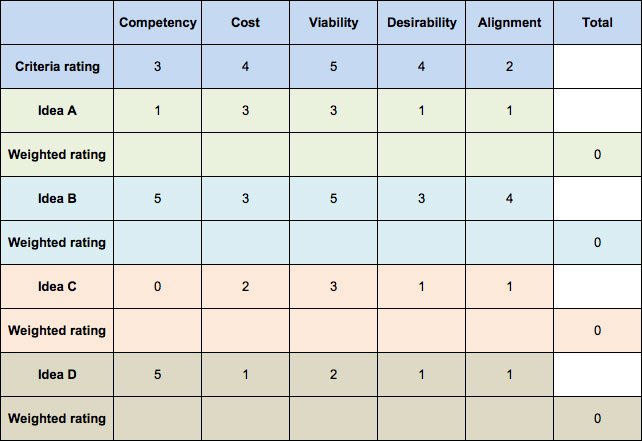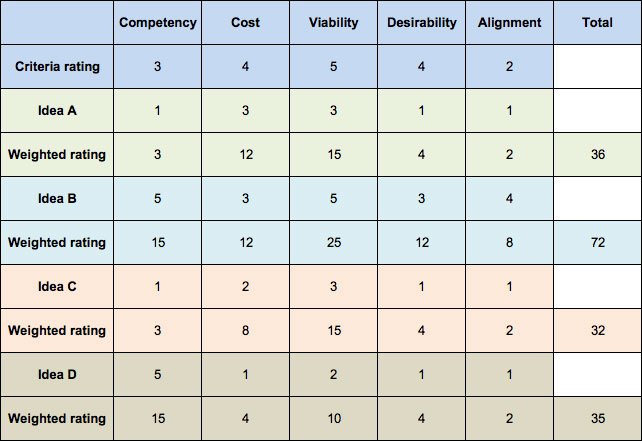How to Use the Decision Matrix to Make Decisions?
Making the right decision is the biggest challenge that designers, managers, and innovators face, especially when there can be more than one possible choice to select from and multiple factors that need to be evaluated to make the right decision. The Decision Matrix (also known as the Grid Analysis and Pugh Matrix Analysis) lets you achieve this target by providing a measurable method to select a specific choice between many based evaluation values. For example, if you would like to buy a laptop and need to choose the right product based on criteria that reflect the required features that meet your needs and daily usage.
Unlike the Six Thinking Hats, the Decision Matrix provides a quantitative method to decide based on rating ideas against selected criteria. That said, choosing between quantitative methods (i.e. Decision Matrix) or qualitative methods (i.e. Six Thinking Hats) is based on the project and the decision to be taken. For example, in software evaluation, quantitative methods (Heuristic Evaluation) successfully determine the features and layout elements chosen in websites or mobile apps.
Read also:
- What Are The Six Thinking Hats? And How to Use Them?
- Decision Trees: Eliminating Uncertainty in the Decision-Making Process
- Vroom-Yetton-Jago: Deciding How to Decide
- How to Use Mind Mapping for Better Thinking
What is the Decision Matrix?
The Decision Matrix is used to define the criteria affecting the decision-making process in a number of choices in hand, and it is based on the Multiple-Criteria Decision Analysis (MCDA). In this method, each criterium is assigned a score based on its importance. The score ranges between five (most important) and one (least important).
Then, this ranking system is used to evaluate the different options (ideas) by assigning a score for its criterium and its application in a given idea. Similar to the criteria rating, it ranges from five to one. The weight of the idea is the sum of each criterium rate multiplied by each idea score. The below section, How to Use the Decision-Making Matrix?, will provide a practical example of applying the Decision Matrix.
Previously, we explored the Decision Tree as a tool for decision-making. It needs time and knowledge to evaluate each choice’s weighted rates and don’t focus on the features associated with each option. This latter method is more suitable for complex decisions that involve multiple factors and stakeholders. The Business Directory defines the Decision Matrix Analysis as:
“a table used in evaluating possible alternatives to a course of action.”
The tool relies on creating a Decision Matrix table where the rows represent the criteria or the features that need to be evaluated, while the columns represent the different choices. You can download the Designorate Decision Matrix template in Excel spreadsheet format.
When to Use the Decision Matrix?
Deciding between multiple choices is surrounded by risks and factors affecting a proper decision-making outcome. During the team discussion, there is an increasing risk of losing track of the criteria that should be considered in the selected choice. Therefore, Decision Matrix has the following benefits:
– It provides a clear idea of the criteria that need to be considered in the final choice and the weight of each choice before starting the decision-making process.
– It eliminates behavioural biases. Instead of choosing based on the favourable personal criteria, clear agreed criteria are solely used to decide.
– It reduces the decision making time by evaluating several choices at the same time. The rating system also speeds up the decision making process.
How to Create the Decision Matrix Table?
In this example, we will learn how to create a Decision Matrix to evaluate a number of innovative ideas and decide which idea is the best choice, can be selected as a new project and will lead to a successful product for the company. In this example, we will name the ideas (Idea 1, 2, and 3) and set the evaluation criteria to the following:
Competency refers to how the new product competes in the market
Cost refers to the cost required to adopt the new idea
Viability determines if the idea is applicable in real life
Desirability refers to how the consumer will accept and interact with the new idea
Alignment refers to how the idea aligns with the company’s production strategy
Step 1
Create a table where the columns represent the evaluation criteria above, and the rows include the choices. In this example, ideas A, B, C, and D will be chosen. Establish a rating scale for each criterion. The rating should range from 1= less importance and 5= high importance. Then, add these rates under each criterion in the table. The figure below shows that the competency got 3, cost= 4, viability=5, desirability= 4, and alignment=2.

Step 2
Now, you need to rate each idea based on each criterion. The rating is again from 1 to 5. 1 means the idea is least qualified based on the chosen criteria. 5 means that the idea is very qualified for the selected criteria. For example, Idea A was rated 1 based on competency, which means the idea is less desirable in market competency.

Step 3
We need to calculate the weighted score for each idea based on each criterion. The weighted value is a result of the multiplication of the criteria rank and the idea rank as demonstrated below:
Idea A weight = criteria rank X idea score
The total weighted score should be written in the last column, as seen in the figure below. Then, the ideas are prioritised from the highest score to the lowest score. In this example, Idea A presents an excellent opportunity for the company to achieve innovation in the market. Based on the final result, Idea B is more likely to succeed in the market, while Idea C is the least idea to achieve market success.

In some situations, the final results may vary from the expected choices. In this case, the rating for each criterion should be reviewed and revised as necessary.
Download the Decision Matrix Template
The Decision Matrix Analysis presents an accessible and measurable method to take decisions based on the rating and scoring of different criteria and compare the choices based on these criteria. The above template allows you to automatically calculate the weighted rank of each idea and decide which idea to select. This template is based on an Excel spreadsheet document. The tool depends more on practising it. It may take some time to adopt it as part of your daily habits, and then it should become easy to use in different situations.
Bibliography
Nicholls, J. (1995). The MCC decision matrix:: a tool for applying strategic logic to everyday activity. Management decision.
Domínguez, C. R., Martínez, I. V., Peña, P. M. P., & Ochoa, A. R. (2019). Analysis and evaluation of risks in underground mining using the decision matrix risk-assessment (DMRA) technique, in Guanajuato, Mexico. Journal of Sustainable Mining, 18(1), 52-59.
Salmerona, J. L., & Smarandacheb, F. (2010). Redesigning Decision Matrix Method with an indeterminacy-based inference process. Multispace and Multistructure. Neutrosophic Transdisciplinarity (100 Collected Papers of Sciences), 4, 151.
Summary:
The Decision Matrix is a tool based on the Multiple-Criteria Decision Analysis (MCDA) and criteria rating. It is used to decide between multiple options based on weighted criteria based on their importance. Each choice is evaluated based on each criterium to evaluate which option is the most appropriate given the defined criteria.
1- Create a table where the columns represent the evaluation criteria above, and the rows include the choices.
2- Establish a rating scale for each criterion from 1 to 5. Where 1 is the lowest importance and 5 is the highest importance.
3- Rate each idea based on each criterion from 1 to 5. Where 1 is the less qualified and 5 is the highest qualified.
4- Multiply the criteria’s rank X idea score
5- Calculate the sum of each idea’s weight






